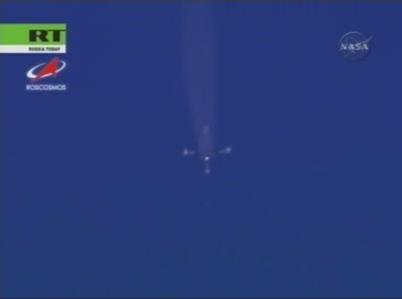R-7 rocket on:
[Wikipedia]
[Google]
[Amazon]
 The R-7 family of rockets (russian: Р-7) is a series of rockets, derived from the
The R-7 family of rockets (russian: Р-7) is a series of rockets, derived from the
 The Korolev Cross is a visual phenomenon observed in the smoke plumes of the R-7 series rockets during separation of the four liquid-fueled booster rockets attached to the core stage.NASA TV coverage of Soyuz TMA-12 launch As the boosters fall away from the rocket, they pitch over symmetrically due to aerodynamic forces acting upon them, forming a cross-like shape behind the rocket. The effect is named after
The Korolev Cross is a visual phenomenon observed in the smoke plumes of the R-7 series rockets during separation of the four liquid-fueled booster rockets attached to the core stage.NASA TV coverage of Soyuz TMA-12 launch As the boosters fall away from the rocket, they pitch over symmetrically due to aerodynamic forces acting upon them, forming a cross-like shape behind the rocket. The effect is named after
Rocket R-7
from
Soviet
The Soviet Union,. officially the Union of Soviet Socialist Republics. (USSR),. was a transcontinental country that spanned much of Eurasia from 1922 to 1991. A flagship communist state, it was nominally a federal union of fifteen nation ...
R-7 Semyorka, the world's first ICBM. More R-7 rockets have been launched than any other family of large rockets.
When Soviet nuclear warheads became lighter, the R-7 turned out to be impractical as a ballistic missile, and there were no other heavy payloads with a military application. However, long-term development has made the rockets useful in the Soviet, and later, Russian space programmes. Their purpose shifted primarily to launching satellites, probes, manned and unmanned spacecraft, and other non-threatening payloads. The R-7 family consists of both missiles and orbital carrier rockets. Derivatives include the Vostok Vostok refers to east in Russian but may also refer to:
Spaceflight
* Vostok programme, Soviet human spaceflight project
* Vostok (spacecraft), a type of spacecraft built by the Soviet Union
* Vostok (rocket family), family of rockets derived from ...
, Voskhod and Soyuz Soyuz is a transliteration of the Cyrillic text Союз ( Russian and Ukrainian, 'Union'). It can refer to any union, such as a trade union (''profsoyuz'') or the Union of Soviet Socialist Republics (Сою́з Сове́тских Социалис ...
rockets, which as of 2022 have been used for all Soviet, and later Russian human spaceflights. The type has a unique configuration where four break-away liquid-fueled engines surround a central core. The core acts as, in effect, a "second stage" after the other four engines are jettisoned. These rockets are expendable.
Later modifications were standardised around the Soyuz design. The Soyuz-2
Soyuz-2 ( GRAU index 14A14) is a modernized version of the Soviet Soyuz rocket. In its basic form, it is a three-stage launch vehicle for placing payloads into low Earth orbit. Compared to the previous versions of the Soyuz, the first-stage ...
is currently in use.
The Soyuz-FG was retired in 2019 in favour of the Soyuz-2.1a. R-7 rockets are launched from the Baikonur Cosmodrome, Plesetsk Cosmodrome
Plesetsk Cosmodrome ( rus, Космодром «Плесецк», r=Kosmodrom "Plesetsk", p=kəsmɐˈdrom plʲɪˈsʲet͡sk) is a Russian spaceport located in Mirny, Arkhangelsk Oblast, about 800 km north of Moscow and approximately 200 ...
, Guiana Space Centre
The Guiana Space Centre (french: links=no, Centre spatial guyanais; CSG), also called Europe's Spaceport, is a European spaceport to the northwest of Kourou in French Guiana, a region of France in South America. Kourou is located approximatel ...
(since 2011, see Soyuz at the Guiana Space Centre
Soyuz at the Guiana Space Centre (also known as Soyuz at CSG or Arianespace Soyuz) was a European Space Agency (ESA) programme for operating Soyuz-ST launch vehicles from Centre Spatial Guyanais (CSG), providing medium-size launch capability f ...
), and the Vostochny Cosmodrome
The Vostochny Cosmodrome (russian: Космодром Восточный, ''Kosmodrom Vostochny'', "Eastern Spaceport") is a Russian spaceport (still partly under construction) above the 51st parallel north in the Amur Oblast, in the Russian ...
(first launch 2016).
Summary of variants
All the R-7 family rockets are listed here by date of introduction. Most of the early R-7 variants have been retired. Active versions (as of 2022) are shown in green.Korolev Cross
Sergey Korolev
Sergei Pavlovich Korolev (russian: Сергей Павлович Королёв, Sergey Pavlovich Korolyov, sʲɪrˈɡʲej ˈpavləvʲɪtɕ kərɐˈlʲɵf, Ru-Sergei Pavlovich Korolev.ogg; ukr, Сергій Павлович Корольов, ...
; the designer of the R-7 rocket. When the rocket is launched into clear skies, the effect can be seen from the ground at the launch site.
See also
* 1957 in spaceflight *List of R-7 launches
This is a list of launches made by the R-7 Semyorka ICBM, and its derivatives. All launches are orbital satellite launches, unless stated otherwise.
Due to the size of the list, it has been split into several smaller articles:
* List of R-7 la ...
* Comparison of orbital launchers families
This article compares different orbital launcher families (although many launchers that are significantly different from other members of the same 'family' have their own separate entries). The article is organized into two tables: the first tabl ...
References
* *External links
Rocket R-7
from
S.P. Korolev Rocket and Space Corporation Energia
PAO S. P. Korolev Rocket and Space Corporation Energia (russian: Ракетно-космическая корпорация «Энергия» им. С. П. Королёва, Raketno-kosmicheskaya korporatsiya "Energiya" im. S. P. Korolyov ...
, a Russian rocket and space contractor
{{DEFAULTSORT:R-07
Space launch vehicles of the Soviet Union
Soviet inventions
Rocket families
Space launch vehicles of Russia